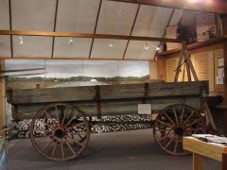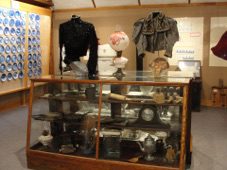

Tracing the Footsteps Our Journey, Purpose & More
In 1993 a group of Danevang residents and former residents formed the Danish Heritage Preservation Society with the purpose of preserving the heritage of the Danish immigrants who settled in the community of Danevang beginning in 1894. The Society bought three acres of land from the Danevang Lutheran Church at the corner of State Highway 71 and County Road 462. Soon thereafter, a residence built in 1898 was donated to the Society and was moved to the purchased site. Over a period of several years, it was repaired and restored to near the original configuration and was furnished with furniture and appliances from the time before 1920. This house was designated The Pioneer House.
At the same time planning and fund raising had begun for a museum building. Construction was begun in 2000 on a building designed to resemble a typical Danish barn with a red roof. Alvin Jensen, a native of Danevang and a retired construction engineer, designed the building and supervised the construction. The building was completed the following spring and was dedicated on June 1, 2001. It contains approximately 6,000 square feet display area on the ground floor plus a kitchen and restroom facilities. The second floor has a meeting room , offices, and work space for processing the artifacts and setting up exhibits.
The Museum contains artifacts and exhibits related to the everyday lives of the pioneer settlers of Danevang. The first exhibits near the entrance stress the ties that still exist with the Mother Country of Denmark, and the Viking influence from the early years of the second millennium. Other displays show the importance of the Danish Lutheran Church,

the public schools, and organized community recreation activities to the early settlers. Since farming has always been the primary occupation in Danevang, the Museum shows samples of the crops that are grown in the area and the progression of the methods and equipment used for growing these crops.
A section of the exhibit area is set aside for descendants of the pioneer families of Danevang to put up exhibits showing the history of their families. The families design and construct the exhibits and install them in this area. Each family display remains in place for approximately one year and then is removed so that another family may use the space.
As well to inviting individuals and families to visit the museum and pioneer house, the Society also encourages tour groups to visit and enjoy the facilities. By prior arrangements, the Museum staff and volunteers will provide structured tours and activities for tour groups such as senior citizens organizations and school groups. These activities can range from a tour of the Museum and Pioneer House with coffee and cookies provided to a tour including also the Danevang Lutheran Church, community hall, and cemetery, with a sit-down Danish meal in the museum.





How to Search our Archives
Our Archived Collection helps researchers find all the records that have been digitized and categorized to date. Follow the link to The Portal of Texas History to research our records. Portal of Texas History
To research, just type in Danevang, your last name, the Danevang Church, the Danevang Coop, or anything pertaining to Danevang, and you can see what we have here at the museum?
*Please note that staff is constantly adding to and updating the collection.
Words for the Past: PJA Petersen, Part III
Another piece from the writings (abridged) of PJA Petersen, who shared the story of the early years in Danevang.
“Then we reached the year 1900. The spring came late. We did not get all of the fields plowed — not by far; consequently, the harvest also became rather late. Then, just as we had commenced picking, the so-called Galveston Storm on September 8 struck us; it picked the cotton for us — gratis! The wind did the most damage. That was another great disappointment, and we were—as so often before—compelled to carry on in the hope of better luck next year. Praised be God for the HOPE!
Fortunately, no loss of life occurred here, but for several days the H.J. Han-sen family suffered great anxiety for their daughter, her husband, and child. For they were in Galveston at the time. Almost naked, they floated on pieces of wreckage all night through. A few days later, they arrived here in Danevang unhurt but without all their possessions. Shortly after, they suffered the great sorrow anyway that their only little child became sick with diphtheria and died. Hansen’s two other children died of the same disease. It was a hard trial for this family, but otherwise, the community was spared.
We talked a good deal about moving away from here, but really, we did not like to do that. Besides, it was almost impossible for us. The pocketbook was empty, and borrowing from relatives and friends in the North had also nearly come to an end. Jobs were not to be had.
A few grew tired and went away. Whether or not they made the right choice is quite a question.
The majority remained and ‘stuck to it,’ and we all survived our tribulations. The horses
did too; they got some feed—a little– and we got food—plenty—and also enough clothes.
Thanks to the mild climate, we did not need much clothing nor wood for fuel, and what little we needed of the latter we could have by hauling it home from the woods. Now the times of free fire-wood have come to an end; - except for the preacher. We reached 1901, and it was our first golden year; that is, for most of us. We got more cows so that we had plenty of milk and butter. Conditions improved considerably when people commenced to come to the east of us and take up land for rice farming. Here was a chance to earn some money for those of us who could be away from home. We could grow sweet potatoes; Bacon was very expensive, and for ourselves to produce it was out of the question. If a man was not poor before, he soon would become so when he got a bunch of hogs to feed. Now, this has changed, especially since we now can buy a lot of rice feed cheaply.”
